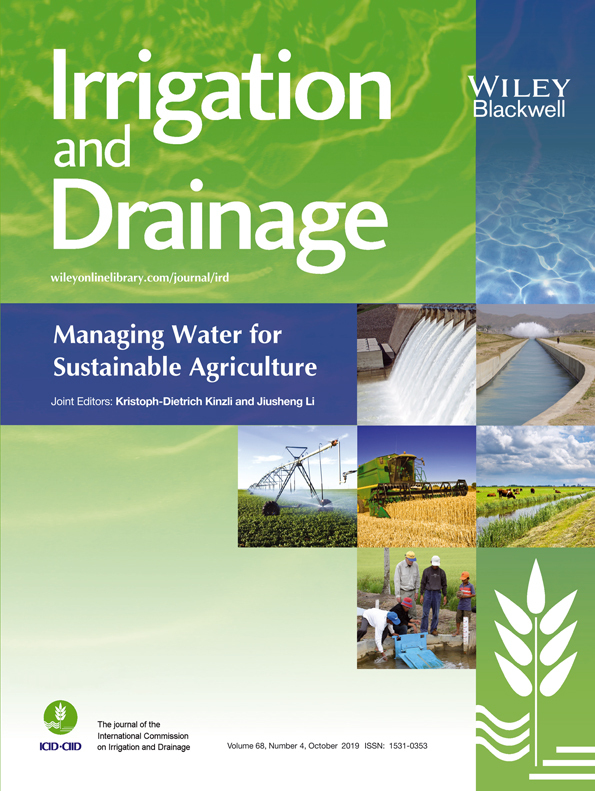AN INVESTIGATION AND CONDITION ASSESSMENT OF THE EXISTING WATER CONTROL INFRASTRUCTURE IN SELECTED SMALLHOLDER IRRIGATION SCHEMES: CASE OF TUGELA FERRY IRRIGATION SCHEME AND MOOI RIVER IRRIGATION SCHEME, SOUTH AFRICA†
Abstract
enThis study investigated and evaluated the condition of the existing water conveyance, storage and control infrastructure in the Mooi River Irrigation Scheme (MRIS) and the Tugela Ferry Irrigation Scheme (TFIS), in KwaZulu-Natal, South Africa. An infrastructure condition assessment (ICA) was undertaken based on inspections and condition scoring or grading. In addition, technical experts were consulted to determine the weights of the structural evaluation criteria using the analytical hierarchy process (AHP). Furthermore, the fishbone ‘Ishikawa’ diagram and the relative causal index (RCI) method were used to carry out the root cause analysis (RCA). For RCI, questionnaires were administered to stakeholders to capture their perception of the causal factors. According to the study, the fishbone ‘Ishikawa’ diagram characterized and identified 23 probable causal factors that led to infrastructure dilapidation. The RCI quantified the causal factors and revealed the converging points between technical experts (te) and the extension workers (ex) regarding causal factors. The converging causal factors were related to maintenance (RCIte = 0.8, RCIex = 0.7), people (RCIte = 0.7, RCIex = 0.7), institutions (RCIte = 0.7, RCIex = 0.6) and the environment (RCIte = 0.8, RCIex = 0.7). The study further revealed that the stakeholders involved had points of divergence on causes of infrastructure decay. Follow-up questionnaires were again administered to discover the reasons for diverging thoughts. The study recommends participatory engagement in process and procedure design for enhanced infrastructure conditions. © 2019 John Wiley & Sons, Ltd.
Résumé
frCette étude a enquêté et évalué les conditions de transport, de stockage et de contrôle des infrastructures de la Moii River (MRIS) et du système d'irrigation de la Tugela Ferry (TFIS) dans la province du KwaZulu-Natal en Afrique du Sud. Une évaluation de l'état des infrastructures a été réalisée, basée sur des enquêtes et d'un indice de notation. De plus, des experts techniques ont été consultés afin de pondérer les critères d'évaluation en utilisant la méthode de la hiérarchie multicritère (MHP ou AHP). En outre le diagramme d'Ishikawa et la méthode d'indice de causalité relative (ICR–RCI) ont été utilisés pour analyser les causes premières (RCA). Pour le RCI, des questionnaires ont été soumis aux parties prenantes pour capter leur perception des facteurs de causalité. D'après l'étude, le diagramme d'Ishikawa a caractérisé et identifié 23 causes possibles conduisant à la détérioration des infrastructures. Le RCI a quantifié les facteurs de causalité et a révélé les points de convergence entre expert(e)s techniques et conseillers agricoles en regard des facteurs de causalité. Les facteurs convergents de causalité sont en relation avec la maintenance (RCIte = 0.8, RCIex = 0.7), les facteurs humains (RCIte = 0.7, RCIex = 0.7), institutionnels (RCIte = 0.7, RCIex = 0.6), et environnementaux (RCIte = 0.8, RCIex = 0.7). En outre, l'étude révèle que les parties prenantes concernées soulevaient des points divergents sur les causes de la dégradation des infrastructures. Des questionnaires de suivi furent à nouveaux distribués pour mieux appréhender les raisons de ces idées divergentes. L'étude recommande un engagement participatif pour les processus et les procédés de conception afin d'améliorer les infrastructures. © 2019 John Wiley & Sons, Ltd.




